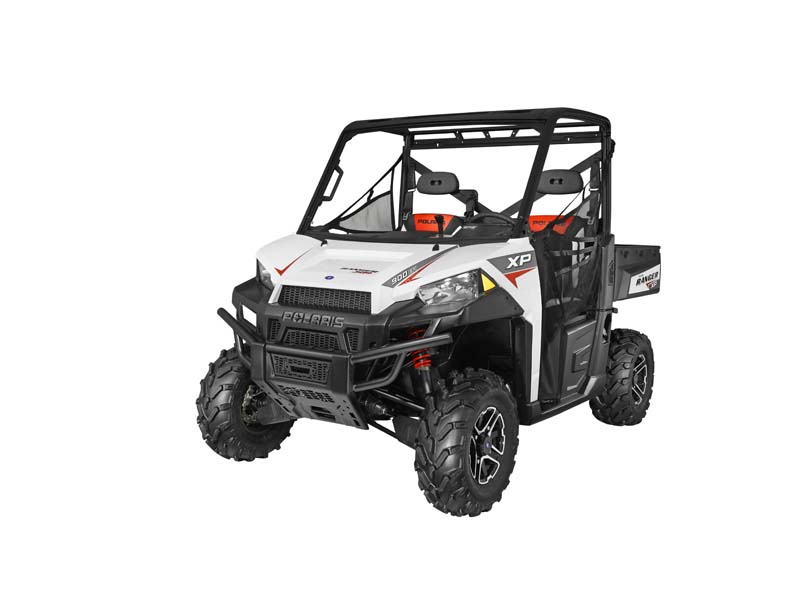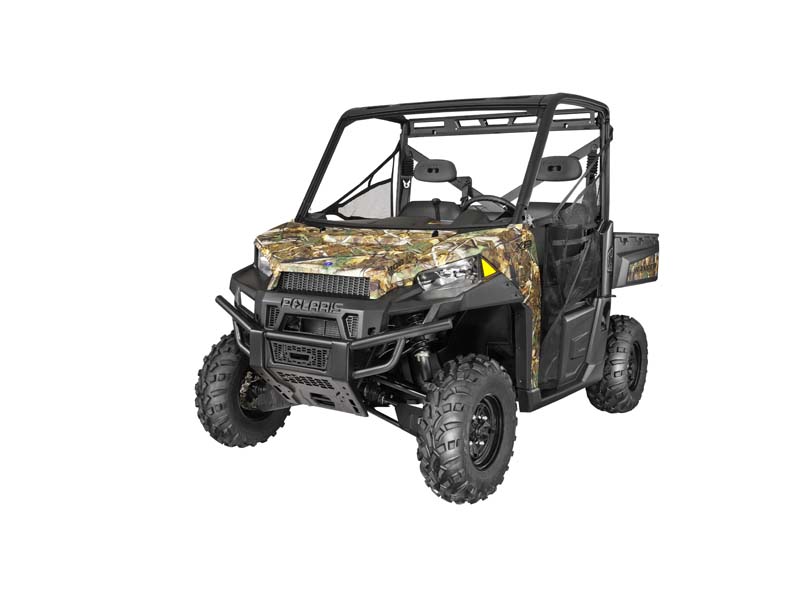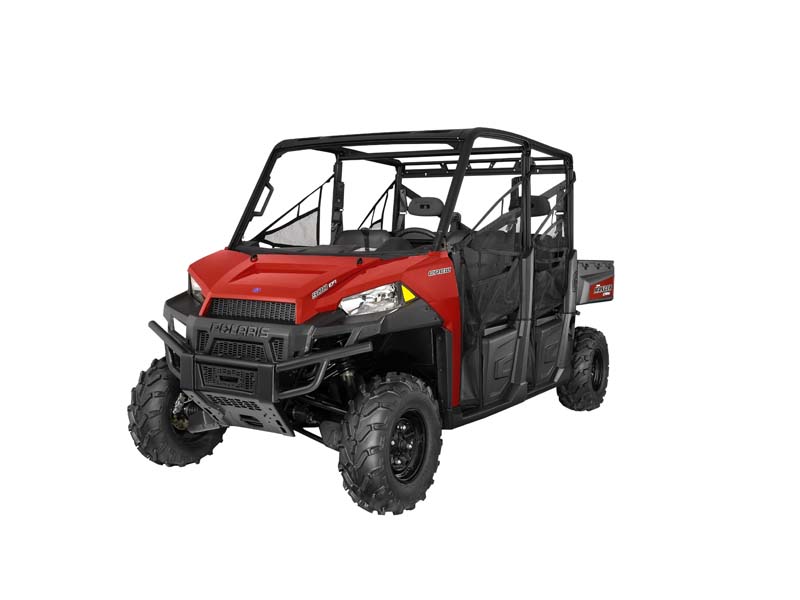
The 2015 Ranger Crew 900 Sage Green is part of another large Polaris recall.

The Ranger XP 900 EPS Hunter Deluxe Edition is included as well.

The wide-ranging recall includes all model year 2015 Polaris Ranger XP 900, XP 900 EPS, and CREW 900 like the Ranger 900 XP Solar Red.
Despite extensive efforts to address recall problems, Polaris announced another large recall of Ranger vehicles. Approximately 51,000 model year 2015 Ranger XP 900 and Ranger Crew utility vehicles are being recalled because “…the heat shield can fall off the vehicle, posing fire and burn hazards…”. The recall also includes about 1,500 2017 Sportsman ATVs that have been sold. Vehicle owners should stop using the vehicles and contact their local dealer for a free repair. (Full recall details follow at the end of the post.)
One??question with all these recall is what impact are they having on the company’s sales. Management has reported losing market share in recent quarterly earnings calls, and a chunk of that is likely to Can-Am, which has had successful introductions of their Maverick X3 models in the sport segment and their Defender models targeting the more utility/work oriented segment. The recalls have been so large and persistent and stretching over such a long period of time that one would have to assume some damage to the Polaris brand, even though Polaris management appears to be reacting??relatively quickly to the overall recall issue. Management reports making high level personnel hires, bringing in other personnel with specific engineering expertise, developing new processes and spending significant financial resources to address the issue. This latest recall came as a result of their new process to more quickly track post-sales issues.
Besides??affecting the brand and sales directly, these recalls may indicate a more deep-seated problem with??the company’s product development process. Some of these recalls are the result of underlying engineering and design issues. How did these issues survive their product development process? Addressing this issue is arguably the most critical.
One of Polaris’ advantages on their way to a dominant position in the off-road vehicle market has been their ability to quickly and regularly produce new vehicle models. What CEO Scott Wine likes to refer to as their “armada” of vehicles provides Polaris with an extensive lineup??of vehicles to cover a wide range of market sub-segments, end-use applications and price points. This has enabled Polaris to better??meet specific customer??needs with more tailored vehicles than their competitors.
The ability to innovate and quickly bring new vehicles to market is even more important now as competition in the side-by-side market has elevated in the past 2-3??years. A host of OEMs are now producing more vehicles, more quickly and attacking a wider range of market sub-segments. This translates into greater head-to-head feature and pricing competition between individual vehicle models. If a weakness is revealed in a product lineup then it needs to??be quickly remedied with a new model or variation of an existing model or that OEM risks losing sales on an ongoing basis. Therefore, the vehicle product development process is critical to success and Polaris will need to fix any underlying problems in their process.
Marc Cesare, Smallvehicleresource.com
The following recall details are from the Consumer Product Safety Commission.
Recall Details
Units: ??About 51,000
Description: This recall involves all model year 2015 Polaris Ranger XP 900, XP 900 EPS, and CREW 900 recreational off-highway vehicles (ROVs). The recalled ROVs were sold in a variety of colors and have either three or six seats and a rear box. ???Ranger??? is printed on the rear box, and ???900??? is printed on the hood of the ROVs. All 2015 Ranger 900 models and vehicle identification numbers (VINs) are included in this recall. The VIN is printed on the frame on the driver???s side towards the rear of the vehicle. To check for recalled vehicles by VIN, visit www.polaris.com.
| Model Year | Model Number | Model |
| 2015 | R15RTA87AA | RANGER 900 XP SAGE GREEN |
| 2015 | R15RTA87AR | RANGER 900 XP SOLAR RED |
| 2015 | R15RTA87AC | RANGER XP 900 POLARIS PURSUIT CAMO |
| 2015 | R15RTE87AA | RANGER XP 900 EPS SAGE GREEN |
| 2015 | R15RTE87AR | RANGER XP 900 EPS SOLAR RED |
| 2015 | R15RUA87AA | RANGER CREW 900 SAGE GREEN |
| 2015 | R15RUA87AR | RANGER CREW 900 SOLAR RED |
| 2015 | R15RUY87AA | RANGER CREW 900-6 SAGE GREEN |
| 2015 | R15RTE87AK | RANGER XP 900 EPS BLACK PEARL |
| 2015
2015 |
R15RTE87AM | RANGER XP 900 EPS SUPER STEEL GRAY |
| 2015 | R15RTE87AS | RANGER XP 900 EPS SUNSET RED |
| 2015 | R15RTE87AW | RANGER XP 900 EPS WHITE LIGHTNING |
| 2015 | R15RTE87AX | RANGER XP 900 EPS SANDSTONE METALLIC |
| 2015 | R15RTE87AZ | RANGER XP 900 EPS SUNSET RED SILVER |
| 2015 | R15RTE87AB | RANGER XP 900 EPS HUNTER EDITION |
| 2015 | R15RUE87AC | RANGER CREW 900 EPS POLARIS PURSUIT CAMO |
| 2015 | R15RUE87AM | RANGER CREW 900 EPS SUPER STEEL GRAY |
| 2015 | R15RUE87AS | RANGER CREW 900 EPS SUNSET RED |
| 2015 | R15RUE87AW | RANGER CREW 900 EPS WHITE LIGHTNING |
| 2015 | R15RUZ87AC | RANGER CREW 900-6 EPS POLARIS PURSUIT CAMO |
| 2015 | R15RUZ87AS | RANGER CREW 900-6 EPS SUNSET RED |
| 2015 | R15RUZ87AW | RANGER CREW 900-6 EPS WHITE LIGHTNING |
| 2015 | R15RTE87AV | RANGER XP 900 EPS VOGUE SILVER DELUXE |
| 2015 | R15RTE87A5 | RANGER XP 900 EPS HUNTER DELUXE EDITION |
| 2015 | R15RTE87A2 | RANGER XP 900 EPS NORTHSTAR DELUXE EDITION |
Incidents/Injuries: ??Polaris has received 13 incident reports involving the recalled ROVs, including five reports of fires. No injuries have been reported.
Remedy: ??Consumer should immediately stop using the recalled ROVs and contact Polaris to schedule a free repair. Polaris is contacting all known purchasers directly.
Sold At: ??Polaris dealers nationwide from April 2014 through March 2017 for between $13,400 and $21,300.
Manufacturer(s): ??Polaris Industries Inc., of Medina, Minn.
Importer(s): ??Polaris Industries Inc., of Medina, Minn.
Manufactured In: ??U.S. and Mexico













